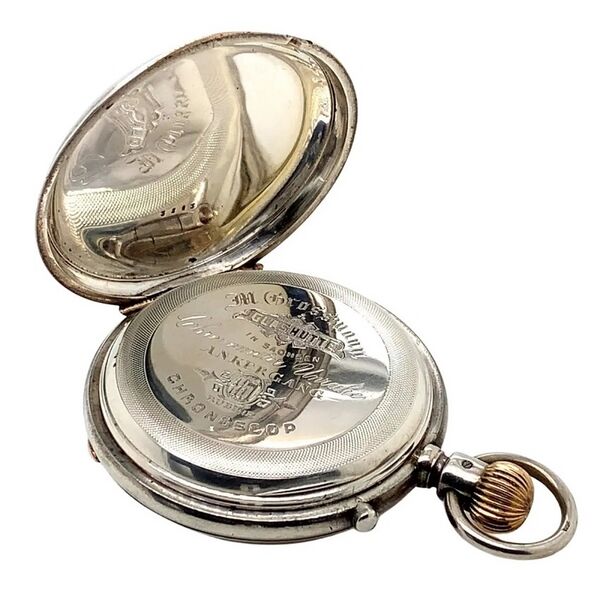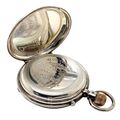Datei:Moritz Grossmann No. 3931 Geh. No. 3813 ca. 1880 (4).jpg

Originaldatei (850 × 850 Pixel, Dateigröße: 170 KB, MIME-Typ: image/jpeg)
Beschreibung
Moritz Grossmann No. 3931 Geh. No. 3813 ca. 1880

|
Alle Bildrechte liegen bei dem Auktionshaus Auktionen Dr. H. Crott. Diese Abbildung ist urheberrechtlich geschützt und steht nicht unter einer freien Lizenz. Für anderweitige Nutzungen außerhalb von Watch-Wiki ist die schriftliche Zustimmung des Urheberrechtsinhabers nötig. |
Silber Gehäuse · guillochiert · Geh.-Nr. 3813. Email Zifferblatt. 3/4-Platinenwerk, große Goldschrauben-Komp.-Unruh. Historisch bedeutender Glashütter Chronograph, so genanntes Chronoscop.
Silver Case Case no. 3813· guilloche pattern. Enamel Dial. 3/4 plate movement, large gold screw compensation balance. A historically important Glashuette chronograph, so called Chronoscop.
Carl Moritz Grossmann was born in Dresden on March 27, 1826; his father was a sorter at the Royal Court Post Office. Moritz grew up in modest circumstances, but his teachers at school soon realised that he was an exceptionally gifted pupil and he received a free place at the "Technische Bildungsanstalt" (which was later to become Dresden’s Technical University). This enabled him to study for two years – just like Ferdinand Adolph Lange some years before him. In 1842 Grossmann began his apprenticeship with the watchmaker Gottfried Friedrich Kumme (sen.) in Dresden and was allowed to end his apprenticeship early because of his unusual talent. He also learnt English, French and Italian; at the same time Grossmann became friends with the watchmaker Ferdinand Adolph Lange, who was 11 years older. Both men were ambitious and meticulous workers, keen to learn and to build watches. His travels took Moritz Grossmann to Altona in 1847 where he worked with chronometer maker Moritz Krille; afterwards he went to stay with watchmaker to the Munich court Josef Bierganz. He went on to La Chaux-de-Fonds, the Swiss stronghold of the watchmaking industry; from there he traveled to England, France, Denmark and Sweden, always on the lookout for opportunities to learn and further his knowledge and abilities in watchmaking. He only returned to Dresden for a short while in 1854 before moving to Glashuette, about 30 km from Dresden. In Glashuette Grossmann invented the "Glashuetter Drehstuhl", a small watchmaker’s lathe. He began devoting himself to the construction of lever escapements and tried to perfect the pivoted detent escapement. He also built precision tools, movement models, fine pocket watches and marine chronometers. Grossmann mastered this multitude of tasks with a team of highly qualified colleagues; he was able to win the two expert watchmakers Ludwig Strasser and Carl Maucksch for his workshop. This allowed Grossmann not only to build his own watches but also pass his knowledge on to others. Grossmann gave lectures, wrote articles for national and international horological magazines and translated technical books such as Claudius Saunier‘s textbook on watchmaking "Lehrbuch der Uhrmacherei", which consisted of several volumes. In 1866 Grossmann was the first German to win a competition at the British Horological Institute in London with his paper "On the detached lever". Moritz Grossmann was also very socially and politically active; he founded the volutary fire brigade of the sports club in Glashuette, the military club and supported the building of the railway link to the Mueglitz valley. After his wife died in 1871, he remarried and the couple had three children. In 1876 Grossmann became a member of the state parliament of Saxony. He initiated and created the concept for the German Watchmaking School in Glashuette; he founded the school in 1878 and served as its first chairman of the board and taught maths and languages at the school. Moritz Grossman died after a stroke on January 23, 1885 in Leipzig, shortly after holding a lecture on the introduction of Universal Time. Just like his friend Ferdinand Adolph Lange he was only 60 years old when he died. After Grossmann’s sudden death his factory in Glashuette was dissolved. Sincere thanks are given to the Grossmann Uhren GmbH for the text and the information provided.
Dateiversionen
Klicke auf einen Zeitpunkt, um diese Version zu laden.
| Version vom | Vorschaubild | Maße | Benutzer | Kommentar | |
|---|---|---|---|---|---|
| aktuell | 12:25, 26. Apr. 2024 |  | 850 × 850 (170 KB) | Andriessen (Diskussion | Beiträge) | Moritz Grossmann No. 3931 Geh. No. 3813 ca. 1880 {{Bildrechte U|dem Auktionshaus Auktionen Dr. H. Crott}} Silber Gehäuse · guillochiert · Geh.-Nr. 3813. Email Zifferblatt. 3/4-Platinenwerk, große Goldschrauben-Komp.-Unruh. Historisch bedeutender Glashütter Chronograph, so genanntes Chronoscop. Silver Case Case no. 3813· guilloche pattern. Enamel Dial. 3/4 plate movement, large gold screw compensation balance. A historically important Glashuette chronograph, so called Chronoscop. Carl… |
Du kannst diese Datei nicht überschreiben.
Dateiverwendung
Keine Seiten verwenden diese Datei.
Metadaten
- Bildgalerie Uhrenmodelle Großmann, Karl Moritz
- Picture gallery watch models Großmann, Karl Moritz
- Galería de imagenes de modelos de relojes Großmann, Karl Moritz
- Afbeeldingen galerij uurwerkmodellen Großmann, Karl Moritz
- Фотогалерея Модели часов Großmann, Karl Moritz
- Galleria fotografica di modelli orologi Großmann, Karl Moritz